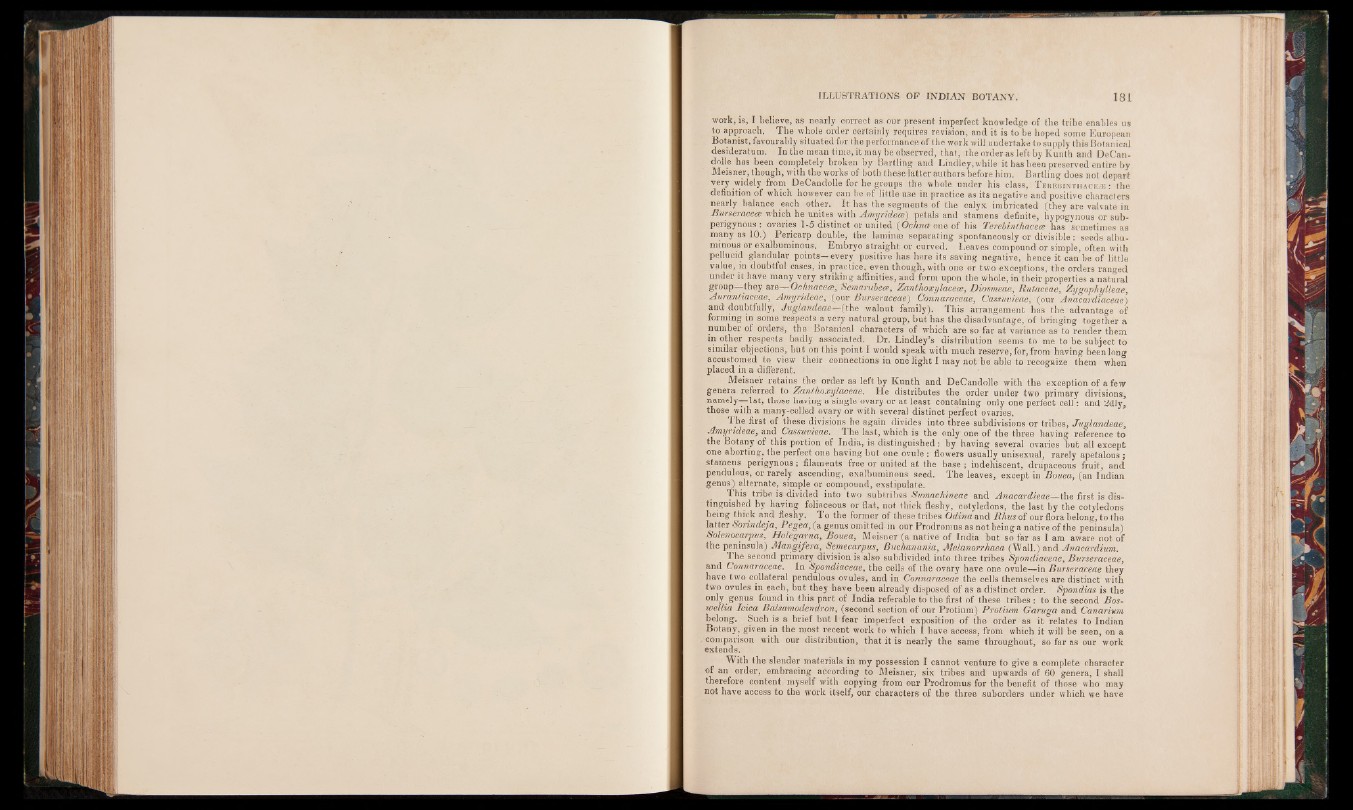
work, is, I believe, as nearly correct as our present imperfect knowledge of the tribe enables us
to approach. The whole order certainly requires revision, and it is to be hoped some European
Botanist, favourably situated for the performance of the work will undertake to supply this Botanical
desideratum. In the mean time, it may be observed, that, the order as left by Kunth and DeCan-
dolle has been completely broken by Bartling and Lindley, while it has been preserved entire by
Meisner, though, with the works of both these latter authors before him. Bartling does not depart
very widely from DeCandolle for he groups the whole under his class, T erebinth ace^s : the
definition of which however can be of little use in practice as its negative and positive characters
nearly balance each other. It has the segments of the calyx imbricated (they are valvate in
Burseracea which he unites with Amyridece) petals and stamens definite, hypogynous or sub-
perigynous : ovaries 1-5 distinct or united (Ochnat one of his Terebinthacece has sometimes as
many as 10.) Pericarp double, the laminas separating spontaneously or divisible: seeds albuminous
or exalbuminous. Embryo straight or curved. Leaves compound or simple, often with
pellucid glandular points^every positive has here its saving negative, hence it can be of little
value, in doubtful cases, in practice, even though, with one or two exceptions, the orders ranged
under it have many very striking affinities, and form upon the whole, in their properties a natural
group—they are—OcImacece, Semarubece, Zanthoxylacece, Diosmeae, Rutaceae, Zygophylleae,
Auranliaceae, Amyrideae, (our Burseraceae) Connaraceae, Cassuvieae, (our Anacardiaceaej
and doubtfully, Juglandeae-—(the walnut family). This arrangement has the advantage of
forming in some respects a very natural group, but has the disadvantage, of bringing together a
number of orders, the Botanical characters of which are so far at variance as to render them
in other respects badly associated. Dr. Lindley’s distribution seems to me to be subject to
similar objections, but on this point I would speak with much reserve, for, from having been long
accustomed to view their connections in one light I may not be able to recognize them when
placed in a different.
Meisner retains the order as left by Kunth and DeCandolle with the exception of a few
genera referred to Zanthoxylaceae. He distributes the order under two primary divisions,
namely—1st, those having a single ovary or at least containing only one perfect cell: and 2dly,
those with a many-celled ovary or with several distinct perfect ovaries.
The first of these divisions he again divides into three subdivisions or tribes, Juglandeae,
Amyrideae, and Cassuvieae. 1 he last, which is the only one of the three having reference to
the Botany of this portion of India, is distinguished: by having several ovaries but all except
one aborting, the perfect one having but one ovule : flowers usually unisexual, rarely apetalous;
stamens perigynous; filaments free or united at the base \ indehiscent, drupaceous fruit, and
pendulous, or rarely ascending, exalbuminous seed. The leaves, except in Bouea, (an Indian
genus) alternate, simple or compound, exstipulate.
This tribe is divided into two subtribes Sumachineae and Anacardieae—the first is distinguished
by having foliaceous or flat, not thick fleshy, cotyledons, the last by the cotyledons
being thick and fleshy. To the former of these tribes Odina and Rhusoi our flora belong, to the
latter Sorindeja, Pegea, (a genus omitted in our Prodromus as not being a native of the peninsula)
Solenocarpus, Holegarna, Bouea, Meisner (a native of India but so far as I am aware not of
the peninsula) Mangifera, Semecarpus, Buchanania, Melanorrhaea (Wall.) and Anacardium.
The second primary division is also subdivided into three tribes Spondiaceae, Burseraceae,
and Connaraceae. In Spondiaceae, the cells of the ovary have one ovule—in Burseraceae they
have two collateral pendulous ovules, and in Connaraceae the cells themselves are distinct with
two ovules in each, but they have been already disposed of as a distinct order. Spondias is the
only genus found in this part of India referable to the first of these tribes : to the second Bos-
wellia Idea Balsamodendron, (second section of our Protium) Protium Garuga and Canarium
belong. Such is a brief but I fear imperfect exposition of the order as it relates to Indian
Botany, given in the most, recent work to which I have access, from which it will be seen, on a
comparison with our distribution, that it is nearly the same throughout, so far as our work
extends.
With the slender materials in my possession I cannot venture to give a complete character
of an order, embracing according to Meisner, six tribes and upwards of 60 genera, I shall
therefore content myself with copying from our Prodromus for the benefit of those who may
not have access to the work itself, our characters of the three suborders under which we have